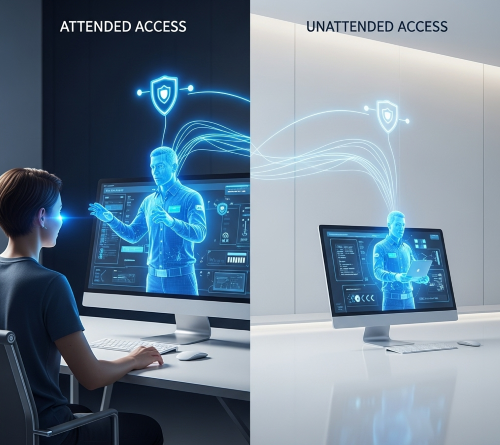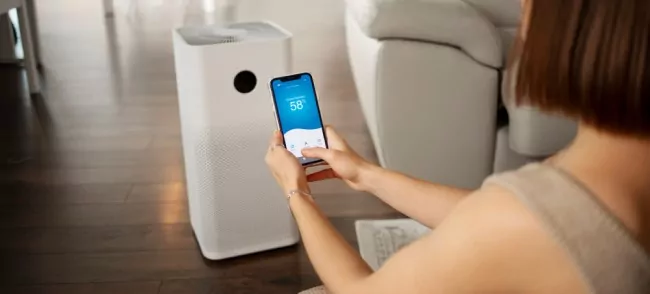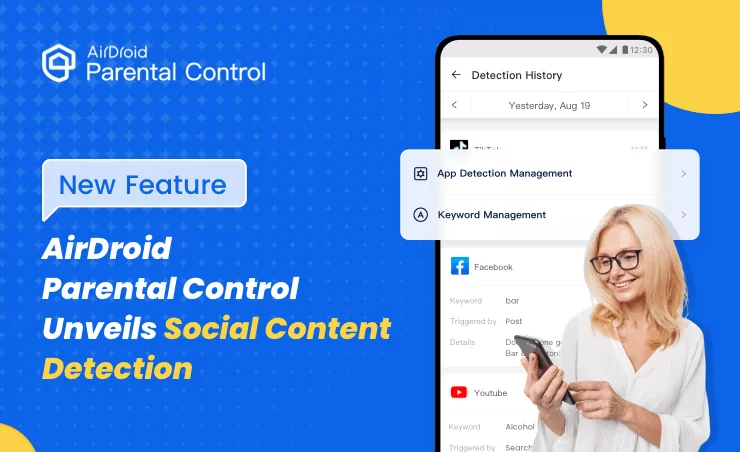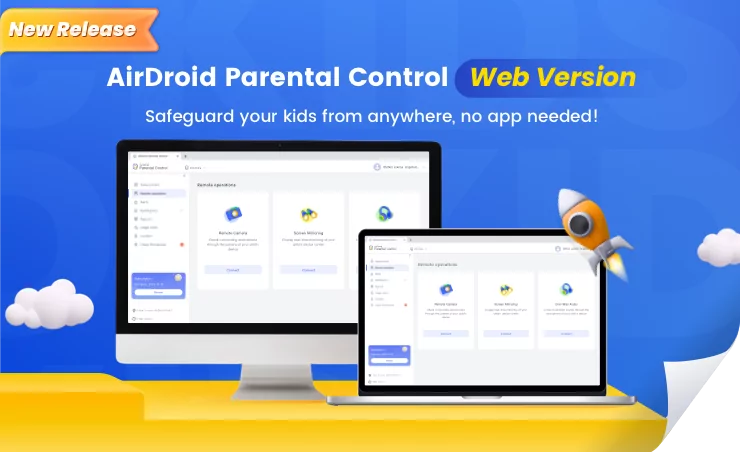What is Unattended Access: Definition & Comparison
Unattended access is a type of remote support that allows IT admins to remote access and control devices without a person on-site or a user's manual confirmation(in the context of enterprise device management).
A decade ago, tech support used to spend hours on the phone helping you troubleshoot something.
Now, you just remote in and handle business, and that’s the end of the story, all thanks to a feature called unattended access.
If you're one of those hardworking IT managers who are always on-call, instead of driving to the office or waiting until morning, you connect remotely and fix it from your couch.
Unattended access technology lets IT teams access devices without someone physically present to click "allow" or enter passwords.
It's like having a master key to every computer in your organization. Whether it's updating software on hundreds of tablets, troubleshooting a server issue, or managing point-of-sale systems, unattended access makes remote management manageable.
IUnattended Access vs. Full Access vs. Attended Access
These three access types are often referred to interchangeably, but they're actually quite different. Learning the distinctions can help you choose the right solution for your specific needs.

User Presence
- Attended access requires permission from someone on the target device. Think of it like knocking on someone's door and waiting for them to open it. The end user has to click "accept" or enter a session code. This works great for one-on-one tech support where the person needs help and is actively participating.
- Unattended access works without anyone present. It's like having your own key to the building. Once configured, IT can connect anytime without user intervention. It’s perfect for servers, kiosks, or any device that needs management outside business hours.
- Full access typically refers to administrative privileges once connected. That grants complete control over the device, regardless of whether the connection is attended or unattended. You can install software, change settings, access files, and do basically anything an admin could do locally.
Primary Use Cases
Each access type fits different scenarios:
- Attended access is superior for customer support and training sessions. When someone calls the help desk saying, "My computer is acting weird," you simply connect with their permission and walk them through the fix.
- Unattended access dominates enterprise environments. Managing 200 tablets across retail locations, updating software on office computers after hours, and monitoring server performance all call for the unattended route.
- Full access comes into play when you need deep system control. Sometimes you only need to view screens or transfer files. Other times, you need to modify registry settings or install drivers. Full access gives you that flexibility.
Permissions and Security
Security levels vary dramatically between these approaches.
- Attended access offers the highest security because human oversight prevents unauthorized connections. Someone has to actively allow each session.
- Unattended access requires more robust security measures since no one's watching the door. This means stronger authentication, encrypted connections, and detailed logging. Many solutions use permanent passwords or certificate-based authentication.
- Full access demands the strictest security protocols. When remote users can modify system settings, you need comprehensive permission controls, session recording, and audit trails. Some organizations restrict full access to specific IT personnel or require multi-factor authentication.
The key is matching your access type to your security requirements. Customer support might use attended access for safety and critical infrastructure definitely needs unattended access with military-grade security.
IIWhy Unattended Access is Essential for Business?
Modern businesses can't afford to wait for someone to be physically present every time a device needs attention. That’s why unattended remote access has become a business necessity, not just a nice-to-have feature. But what is unattended remote access? The ability to connect and control a device remotely without anyone present at that device. Let’s see why it’s so important in the business world:
- Operational efficiency tops the list of benefits. When your POS system goes down during peak hours, you can't wait for a technician to drive across town. All you have to do is connect remotely, diagnose the problem, and get customers moving again. This immediate response capability transforms how IT teams operate.
- Cost reduction follows closely behind. Sending a technician to fix a simple software issue costs travel time, mileage, and hourly rates. Multiply that across hundreds of incidents per year. Remote access eliminates most of these truck rolls, saving thousands in operational expenses.
- 24/7 management rounds out the core benefits. Servers don't crash only during business hours, and critical updates can't always wait until Monday morning. Unattended access means your IT team can maintain systems around the clock without being physically present. It’s a proactive approach that prevents small issues from becoming big problems.
Consider a retail chain with locations across the country. Without unattended access, a simple software update requires coordinating with local staff, scheduling visits, and hoping nothing goes wrong after hours.
With unattended access, IT pushes updates overnight while stores are closed. There’s no disruption, no coordination headaches, and no overtime costs.
IIIWhat to Consider When Implementing Unattended Access
Rolling out unattended access isn't just about picking software and hoping for the best. Smart implementation requires careful planning around several critical factors.
Security
Security should be your top priority. You're essentially creating permanent backdoors into your devices, and this convenience comes with serious responsibility.
Look for solutions that offer multi-layered security, including strong encryption, certificate-based authentication, and comprehensive logging.
Consider role-based access controls too. Not every IT person needs full administrative rights to every device.
Some technicians might only need screen-sharing capabilities, while senior admins require full system access.
Granular permissions prevent insider threats and limit damage from compromised accounts.
Regular security audits become important. Who accessed what devices? When did sessions occur? What changes were made? Your unattended access solution should provide detailed audit trails that satisfy compliance requirements and help investigate incidents.
ROI (Return on Investment)
Calculate your expected return before committing to any solution. Factor in current costs for on-site visits, travel time, and business downtime. Compare these against software licensing fees and implementation costs.
Most businesses see positive ROI within six months. The savings add up quickly when you eliminate travel expenses and reduce response times.
A restaurant chain might save $50,000 annually by remotely managing its POS systems instead of sending technicians to every location.
Don't forget indirect benefits, either. Faster problem resolution improves customer satisfaction, and proactive maintenance prevents costly outages. These soft benefits often exceed direct cost savings.
Compatibility
Your unattended access solution needs to work with your existing infrastructure. Check operating system support carefully. Some solutions excel on Windows but struggle with Mac or Linux environments. Others handle mobile devices better than desktop computers.
Network compatibility matters too. Will the software work through your firewalls? Does it require specific ports or protocols? How does it handle NAT traversal? These technical details determine whether the implementation goes smoothly or becomes a nightmare.
Integration capabilities can make or break deployment success. Look for solutions that work with your existing ticketing system, monitoring tools, and user directory. Seamless integration reduces training requirements and improves adoption rates.
Balance IT Control with User Privacy
The IT control and user privacy balance represents one of the biggest challenges in unattended access deployment.
IT teams need sufficient control to manage devices effectively. Users deserve privacy and shouldn't feel like Big Brother is watching.
Establish clear policies about when and why unattended access will be used and communicate these policies to affected users. Transparency builds trust and reduces resistance to the technology.
Consider implementing session notifications that alert users when remote connections occur. Alerts support transparency without requiring permission for each session. Users know when their devices are being accessed while IT retains the ability to work efficiently.
Some organizations create "IT maintenance windows" where unattended access is expected to occur. Users enjoy the predictability while feeling confident that IT can perform necessary tasks without interruption.
IV. FAQs
To determine the "most safe" unattended access software, you need to evaluate its security features. Look for solutions that offer:
- End-to-end encryption (E2E): This ensures that data transmitted between devices is encrypted and cannot be intercepted by unauthorized parties.
- Two-factor authentication (2FA): This adds an extra layer of security, requiring a second form of verification in addition to a password.
- Granular access controls: The ability to set specific permissions for different users or roles helps prevent misuse.
- Session logging and audit trails: These features record all activity during a remote session, which is crucial for monitoring and accountability.
- Compliance certifications: Certifications like SOC 2 or ISO 27001 indicate that the provider has undergone a rigorous, independent security audit. Popular and highly-rated options known for strong security include AirDroid Business and TeamViewer.
- Digital signage and kiosk management: Remotely updating content, troubleshooting, and maintaining public displays and self-service terminals.
- Point-of-sale (POS) system support: Quickly resolving issues with cash registers and payment systems to prevent business interruptions.
- Remote office support: Providing IT assistance to branch offices or remote locations that don't have on-site IT staff.












Leave a Reply.